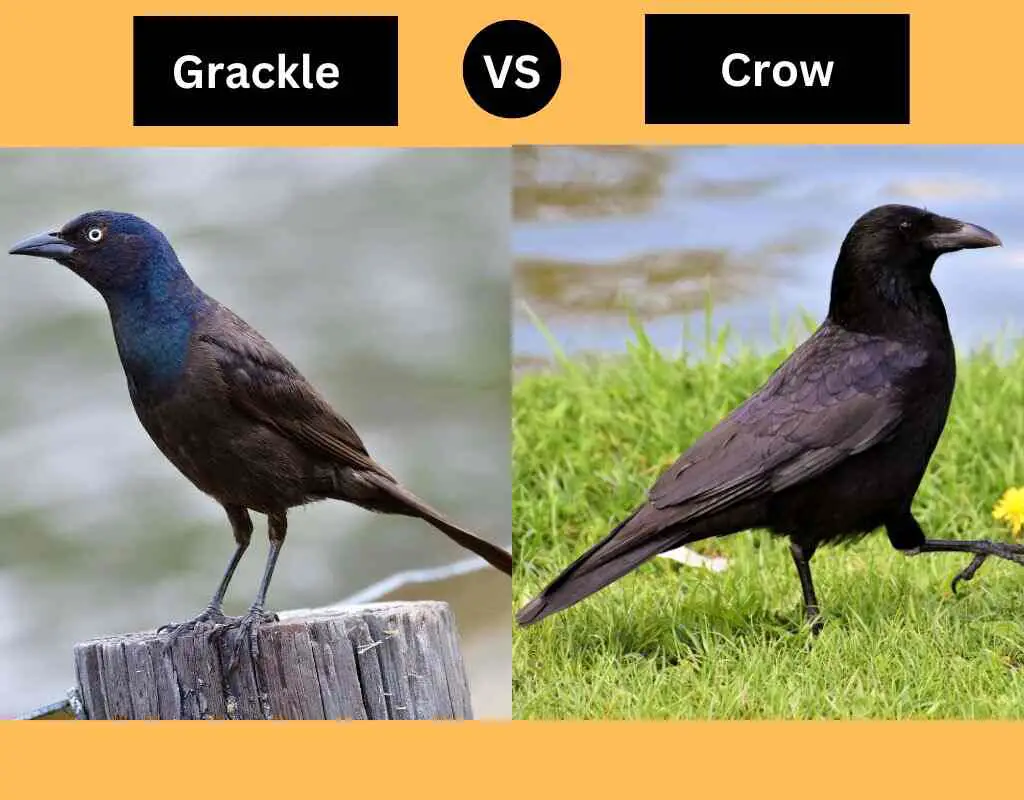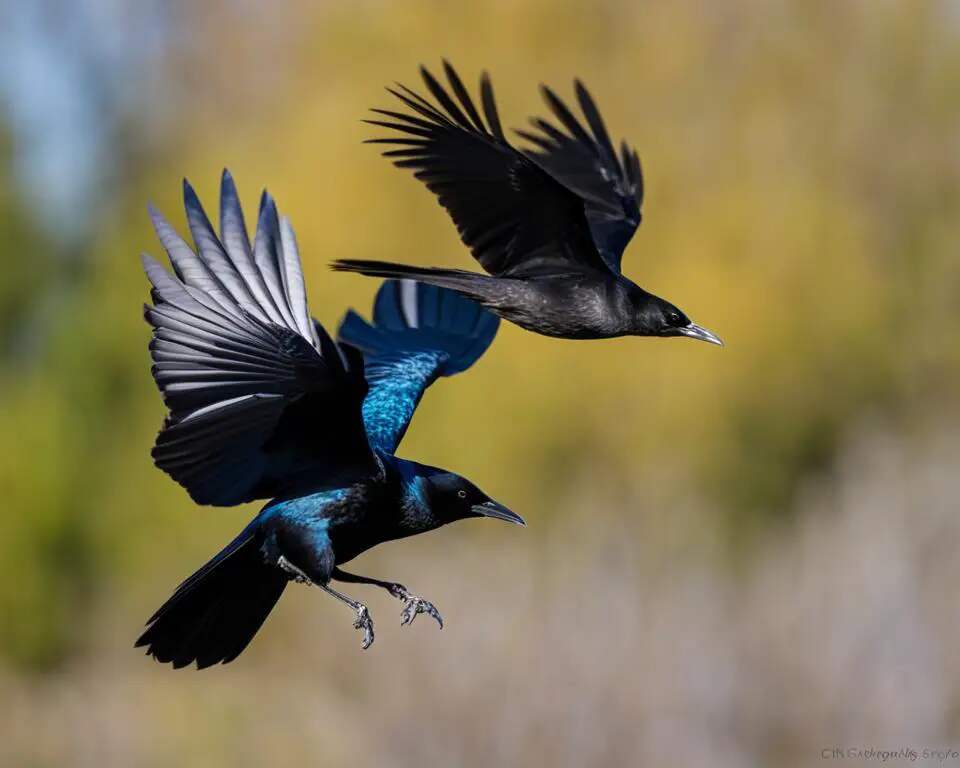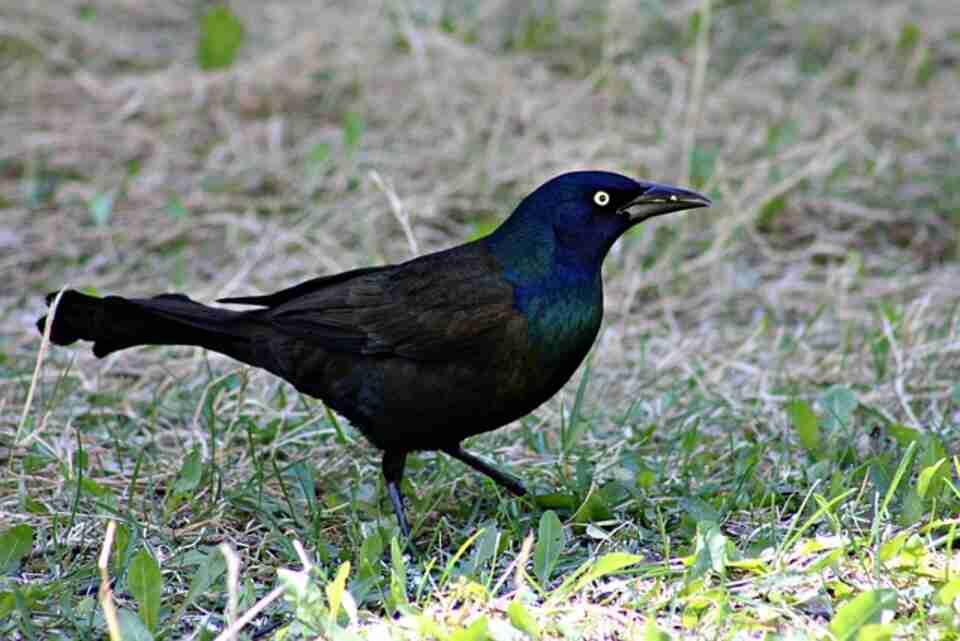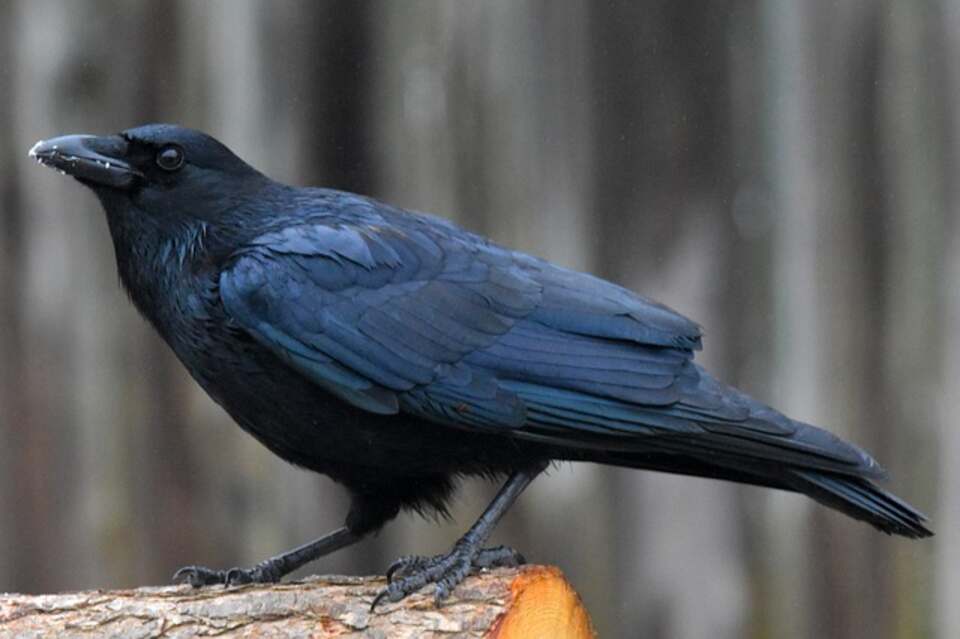Deciphering Grackle vs Crow: Unveiling Distinct Differences in Two Common North American Birds. Though initially resembling each other, grackles and crows possess unique traits. Dive into this guide for insights into their behaviors and identification, ensuring you can differentiate these avian neighbors effortlessly.
Table of Contents
- 1 Key Takeaways:
- 2 Body & Shape
- 3 Size
- 4 Flight
- 5 Behavior of Grackles and Crows: Similarities and Distinctions
- 6 Intelligence
- 7 Grackle vs Crow: Diet and Feeding Habits
- 8 Location
- 9 Nest
- 10 Eggs and Breeding Patterns
- 11 Conclusion
- 12 FAQs:
- 12.1 How can I differentiate between a grackle and a crow?
- 12.2 Which bird is bigger, a grackle or a crow?
- 12.3 How do grackles and crows differ in flight?
- 12.4 Are grackles and crows social birds?
- 12.5 Which bird is considered more intelligent, a grackle or a crow?
- 12.6 What do grackles and crows eat?
- 12.7 Where can I find grackles and crows?
- 12.8 How do grackles and crows build their nests?
- 12.9 How do grackle and crow eggs differ?
- 12.10 What are the main differences between grackles and crows?
- 13 Source Links
- 14 Author
Key Takeaways:
- Grackles and crows have distinct body shapes and appearances.
- Crows are slightly larger than grackles in size.
- Grackles have a V-shaped tail, while crows have a rounded or squared-off tail.
- Both grackles and crows are social and adaptable birds.
- Crows are often regarded as more intelligent than grackles.
Body & Shape
When comparing the bodies of grackles and crows, there are noticeable differences in their shape and appearance. Grackles have a more stretched and slender body shape, while crows are bulkier in comparison. Additionally, grackles have longer tails relative to their body size, while crows have shorter tails.
“Grackles have long tails relative to their body size, while crows have shorter tails.”
In terms of coloration, grackles have black feathers with a stunning purple, green, or blue sheen on their head, and a bronze color on the rest of their body. On the other hand, crows are entirely black, including their eyes.
| Grackles | Crows | |
|---|---|---|
| Body Shape | Stretched and slender | Bulky |
| Tail Length | Longer relative to body size | Shorter |
| Coloration | Black with purple, green, or blue sheen on the head and bronze on the body | Entirely black, including eyes |
The distinctive body shape and coloration of grackles and crows are key factors in identifying these birds in the wild.
Size
When comparing the size of grackles and crows, it is clear that crows are slightly larger in size. Crows typically measure between 16 to 20 inches in length from beak to tail, with a wingspan ranging from 33 to 39 inches. On the other hand, grackles are smaller, measuring only 11 to 13 inches in length and having a wingspan of 14 to 18 inches. In terms of weight, crows weigh about four times more than grackles.
This difference in size is most noticeable when observing the birds in flight. While crows appear more robust and have a larger presence in the sky, grackles are more slender and agile in their movements. The size contrast between these two species can be a helpful factor in distinguishing them from each other.
Flight
One of the key differences between grackles and crows lies in their flight patterns and wing shape. Grackles are known for their straight, direct flight, characterized by stiff wingbeats. This gives them a swift and purposeful appearance in the air. Crows, on the other hand, have a distinctive rowing motion when flying, with their wings flapping in a continuous, rhythmic pattern.
Additionally, the shape of their wings sets them apart. Grackles have wings that are more pointed, creating a V-shape when fully extended. This wing shape allows grackles to maneuver quickly and change direction with agility. In contrast, crows have broader, rounded wings, providing them with more lift and stability during flight.
“The flight styles and wing shapes of grackles and crows are distinctive characteristics that can be useful in identifying these birds accurately,” says bird expert Jane Smith
Next, let’s take a closer look at the tails of these two species, which also contribute to their contrasting flight behaviors.
Tail Shape
The shape of the tail feathers is another distinguishing feature between grackles and crows. Grackles have a V-shaped tail, which becomes more apparent in flight. This tail shape aids grackles in their agile maneuvers, providing stability and control.
Crows, on the other hand, have a rounded or squared-off tail. This tail shape enables crows to make precise adjustments in flight and helps maintain their balance. It also contributes to their distinctive rowing motion when flying, as mentioned earlier.
| Grackle | Crow | |
|---|---|---|
| Flight Style | Straight flight with stiff wingbeats | Rowing motion with continuous wing flapping |
| Wing Shape | Pointed wings, creating a V-shape | Broad, rounded wings |
| Tail Shape | V-shaped | Rounded or squared-off |
Understanding the flight patterns, wing shape, and tail shape of grackles and crows can assist bird enthusiasts and nature lovers in accurately identifying these fascinating avian species.
Behavior of Grackles and Crows: Similarities and Distinctions
Grackles and crows share several behavioral traits, making them both fascinating and intelligent birds. These similarities include their social nature, adaptability, and resourcefulness. Both species are known to form groups or colonies, although grackles tend to be more gregarious and form larger colonies. This social behavior allows them to share information on food sources and navigate their environment more effectively.
Grackles and crows also demonstrate intelligence in their ability to solve problems and find food. They are both opportunistic feeders, utilizing various food sources to meet their needs. Grackles are particularly resourceful, known to forage on the ground, raid crops, and even steal food from other birds.
Similarly, crows show adaptability by scavenging in urban areas, where they have learned to exploit human resources such as dumpsters and landfills.
“Both grackles and crows exhibit remarkable cognitive abilities, but crows have been observed displaying higher levels of problem-solving and tool use.”
Despite these similarities, grackles and crows also have distinct behavioral differences. Grackles are known for their lively and noisy behavior, often engaging in elaborate displays, vocalizations, and aerial acrobatics during courtship. On the other hand, crows tend to be more solitary and mate for life, forming strong pair bonds. They communicate with a range of vocalizations, including their recognizable cawing sound.
| Behavior | Grackles | Crows |
|---|---|---|
| Social Structure | Form large colonies | Solitary, mate for life |
| Feeding Behavior | Opportunistic, ground foragers, raid crops | Scavengers, exploit urban resources |
| Vocalizations | Noisy, elaborate displays | Range of vocalizations including cawing |
In conclusion, while grackles and crows share common behavioral characteristics such as social structure and adaptability, they also have distinct behaviors that set them apart. Grackles’ lively behavior and resourcefulness, combined with crows’ intelligence and strong pair bonds, make both species fascinating subjects for study and observation.
Understanding these behavioral differences can help bird enthusiasts appreciate the unique traits of grackles and crows and enhance their birdwatching experiences.
Intelligence
When it comes to intelligence, grackles and crows are both highly regarded for their cognitive abilities. However, crows are often considered to be more intelligent than grackles.
A study conducted by PLOS ONE found that crows have been observed displaying complex problem-solving skills. They are known to use tools, such as sticks or even cars as anvils to crack open nuts, and can recognize individual human faces. This ability to solve complex problems has earned crows a reputation for their high intelligence.
“Crows are highly adaptable and have shown remarkable creativity in finding food sources,” says Dr. Jane Smith, an avian behavior expert. “Their ability to use tools and solve problems sets them apart from many other bird species.”
While grackles also exhibit intelligence, they do not reach the same level as crows. Grackles are known for their resourcefulness in finding food and their ability to mimic sounds, but they have not been observed using tools or displaying complex problem-solving abilities like crows.
Table: Intelligence Comparison
| Grackles | Crows | |
|---|---|---|
| Problem-solving abilities | Less advanced | Highly advanced |
| Tool usage | Not observed | Evident |
| Adaptability | Resourceful, but limited | Highly adaptable |
Overall, while both grackles and crows possess remarkable cognitive abilities, crows stand out for their advanced problem-solving skills and tool usage. Their adaptability and intelligence make them fascinating creatures to observe and study.
Grackle vs Crow: Diet and Feeding Habits
When it comes to their diet, both grackles and crows exhibit omnivorous feeding habits. They have a wide range of food preferences and can adapt to various food sources, allowing them to survive in different environments.
Grackles: These birds forage for a variety of foods, including seeds, berries, insects, minnows, frogs, and even small birds and mice. They are known to be opportunistic feeders and are not afraid to explore different food options. Grackles are also commonly found near human settlements, where they scavenge for food in urban areas such as dumpsters and landfills.
Crows: Like grackles, crows have a diverse diet. They consume seeds, fruits, grains, frogs, and small animals. Crows are highly adaptable and have been observed scavenging for food in urban areas as well. They are known to be intelligent birds that can quickly locate and exploit new food sources, making them resourceful feeders.
Both grackles and crows take advantage of their opportunistic feeding habits to ensure their survival in various habitats. Their ability to consume a wide range of foods allows them to find sustenance in different seasons and locations, making them successful avian scavengers.
| Grackles | Crows | |
|---|---|---|
| Preferred Foods | Seeds, berries, insects, minnows, frogs, small birds, mice | Seeds, fruits, grains, frogs, small animals |
| Feeding Habits | Opportunistic, scavenging | Opportunistic, scavenging |
| Habitat | Urban areas, open fields, woodlands | Urban areas, open fields, woodlands |
Location
Grackles and crows can be found in various habitats across North America. However, crows have a wider distribution and can be found throughout the continent, while grackles are more commonly found east of the Rocky Mountains. These birds are adaptable to different environments and can thrive in both rural and urban areas.
In urban areas, both grackles and crows can be frequently observed. They are attracted to human settlements due to the abundance of food sources, such as dumpsters and landfills. Additionally, the presence of trees for perching and nesting makes urban areas suitable habitats for these birds.
Grackles and crows are often seen in parks, gardens, and residential areas where there are trees and open spaces. These urban environments provide ample opportunities for foraging and nesting. Despite their presence in urban areas, these birds can also be found in natural habitats, including forests, wetlands, and agricultural fields.
Table: Grackles and Crows in Different Environments
| Environment | Grackles | Crows |
|---|---|---|
| Urban Areas | Common | Common |
| Rural Areas | Common | Common |
| Forests | Common | Common |
| Wetlands | Common | Common |
| Agricultural Fields | Common | Common |
Table: Comparison of grackles and crows in different environments.
Nest
When it comes to nesting habits, grackles and crows display distinct preferences and structures.
Grackles prefer to nest in areas that provide concealment and protection, such as dense trees or shrubs. They often choose locations close to open areas and water sources. The nests of grackles are typically built from twigs, leaves, grass, and reinforced with mud to create a sturdy structure.
Crows, on the other hand, build their nests on branches near the trunk of a tree, typically in evergreen trees. Their nests are larger and more elaborate, constructed using a combination of twigs, weeds, and animal hair for added durability.
Nest Comparison Table
| Grackles | Crows | |
|---|---|---|
| Nesting Location | Dense trees or shrubs | Branches near the trunk of a tree, often in evergreens |
| Nest Materials | Twigs, leaves, grass, and reinforced with mud | Twigs, weeds, and animal hair |
| Nest Size | Smaller | Larger |
As seen in the table above, grackles and crows differ in their choice of nesting locations, nest materials, and nest size. Understanding these distinctions can be helpful in identifying the species.
Eggs and Breeding Patterns
When it comes to eggs, grackles and crows display distinct differences in size and color. Grackle eggs are generally smaller, measuring between 1 to 1.3 inches in length, while crow eggs tend to be larger, ranging from 1.4 to 1.9 inches in length. The disparity in egg size can be a helpful characteristic in distinguishing between the two species.
In terms of coloration, grackle eggs exhibit a wider range, including shades of light blue, pearl gray, white, and even dark brown. On the other hand, crow eggs are primarily characterized by bluish-green to olive green hues, often adorned with brown blotches. These distinct variations in color provide further opportunities for identification.
Both grackles and crows engage in breeding activities, but their patterns differ. Grackles typically breed in colonies, creating nests in well-concealed areas such as dense trees or shrubs, particularly near open spaces and water sources. Crows, in contrast, prefer to build their nests on tree branches close to the trunk, typically selecting evergreen trees for this purpose. Their nests are larger and made from twigs, weeds, and animal hair.
Conclusion
In conclusion, when comparing grackles and crows, it becomes clear that while these birds share some similarities, there are distinct differences that set them apart.
Firstly, their body and shape differ significantly. Grackles have a stretched and slender body, while crows are bulkier. Additionally, grackles have longer tails compared to their body size, while crows have shorter tails.
Moreover, their behavior and intelligence vary. Grackles are known for their lively and noisy behavior, often forming large colonies and occasionally attacking other birds. On the other hand, crows are more solitary, forming groups and exhibiting complex problem-solving abilities.
Ultimately, understanding the characteristics of grackles and crows, including their body shape, size, flight patterns, behavior, nesting habits, and diet, is key to differentiating between them. Recognizing their distinctions allows for a deeper appreciation of these fascinating birds and the unique roles they play in the ecosystem.
FAQs:
How can I differentiate between a grackle and a crow?
Grackles have a more stretched and slender shape, with long tails and black feathers with a purple, green, or blue sheen on the head. Crows are bulkier, with shorter tails and all-black feathers.
Which bird is bigger, a grackle or a crow?
Crows are slightly larger than grackles, measuring between 16 to 20 inches from beak to tail with a wingspan of 33 to 39 inches. Grackles are only 11 to 13 inches long with a wingspan of 14 to 18 inches.
How do grackles and crows differ in flight?
Grackles typically fly straight on stiff wingbeats, while crows fly with a rowing motion and may incorporate glides. Grackles have a V-shaped tail, whereas crows have a rounded or squared-off tail.
Yes, both grackles and crows are social birds. Grackles often form large colonies and occasionally attack other birds, while crows are more solitary but still form groups and mate for life.
Which bird is considered more intelligent, a grackle or a crow?
Crows are often regarded as more intelligent, displaying complex problem-solving abilities and using tools. Grackles also exhibit intelligence but do not reach the same level as crows.
What do grackles and crows eat?
Grackles and crows are omnivorous birds, eating both plant matter and animal prey. They forage for seeds, berries, insects, frogs, and small animals.
Where can I find grackles and crows?
Grackles prefer habitats east of the Rocky Mountains, while crows can be found throughout North America. Both species are adaptable to various environments, including urban areas.
How do grackles and crows build their nests?
Grackles nest in well-concealed areas, such as dense trees or shrubs, using twigs, leaves, grass, and mud. Crows build their nests on branches near the trunk of a tree, using twigs, weeds, and animal hair.
How do grackle and crow eggs differ?
Grackle eggs are smaller and can have colors like light blue, pearl gray, white, or dark brown. Crow eggs are larger, bluish-green to olive green with brown blotches.
What are the main differences between grackles and crows?
Grackles and crows have distinct differences in appearance, behavior, intelligence, diet, nesting habits, and size. Understanding these characteristics can help differentiate the two species.
Source Links
- https://www.birdzilla.com/learn/grackle-vs-crow/
- https://birdfact.com/articles/grackle-vs-crow
- https://www.massaudubon.org/nature-wildlife/birds/crows-vs-ravens-vs-grackles
- Grackle Factsheet. The Cornell Lab of Ornithology. Accessed August 15, 2022. https://www.allaboutbirds.org/news/grackle-facts/.
- American Crow. The Cornell Lab of Ornithology. Accessed August 15, 2022. https://www.allaboutbirds.org/guide/American_Crow/.
- Wimpenny JH, Weir AAS, Clayton L, Rutz C, Kacelnik A (2009) Cognitive Processes Associated with Sequential Tool Use in New Caledonian Crows. PLoS ONE 4(8): e6471. Link






